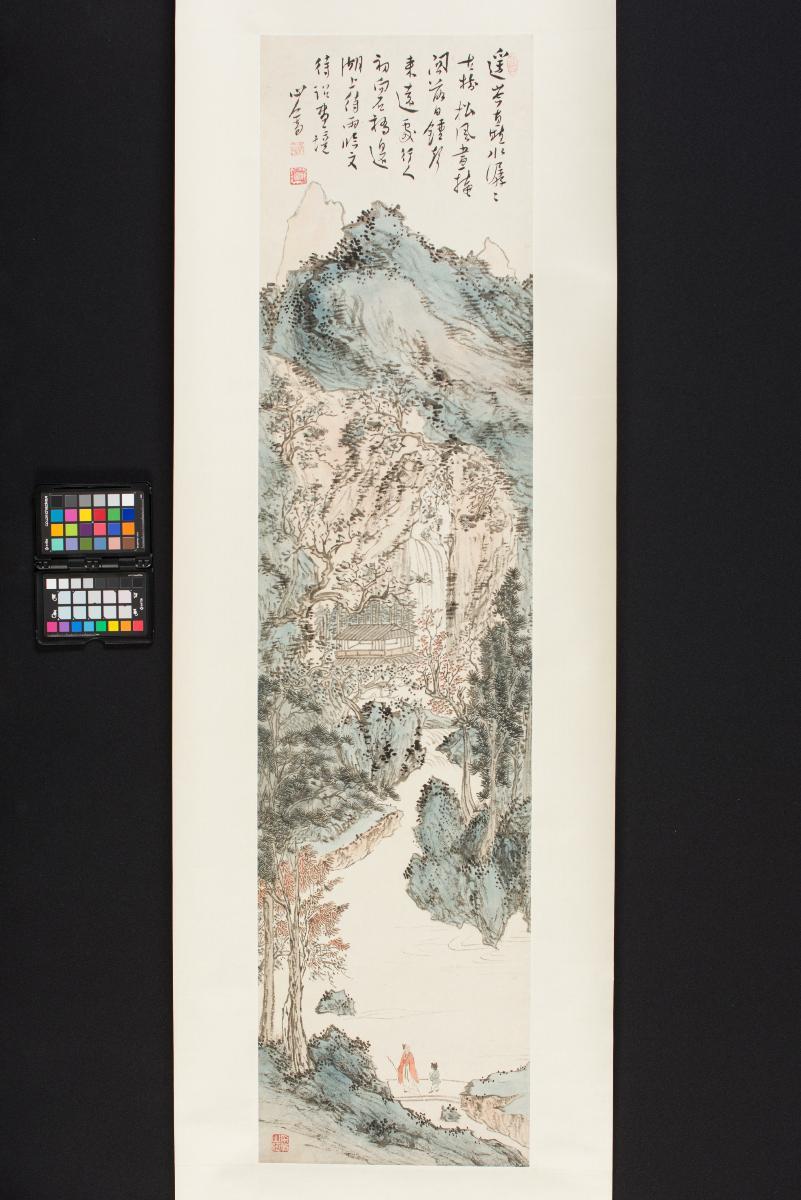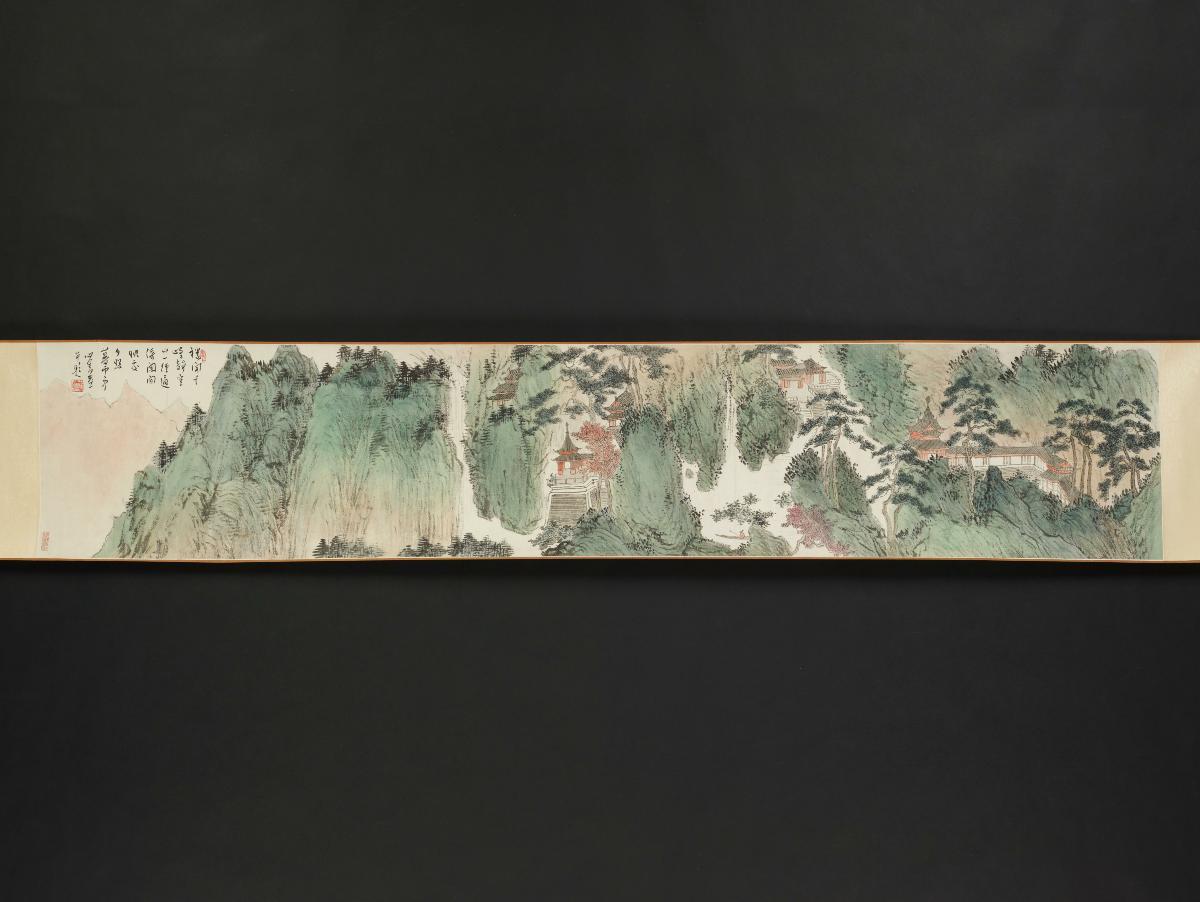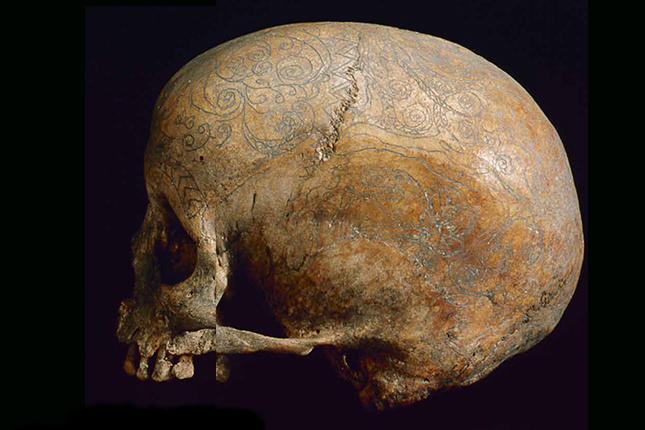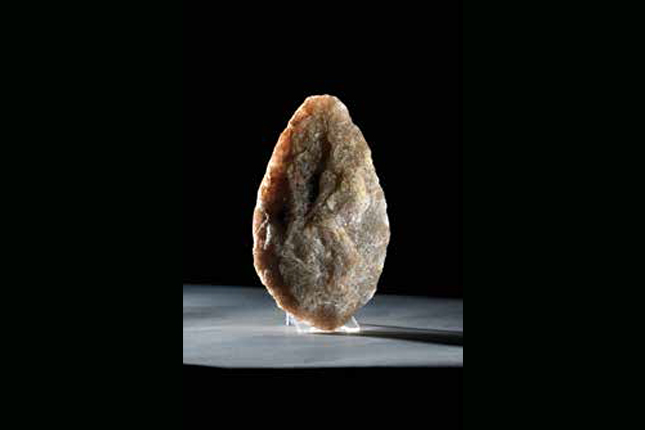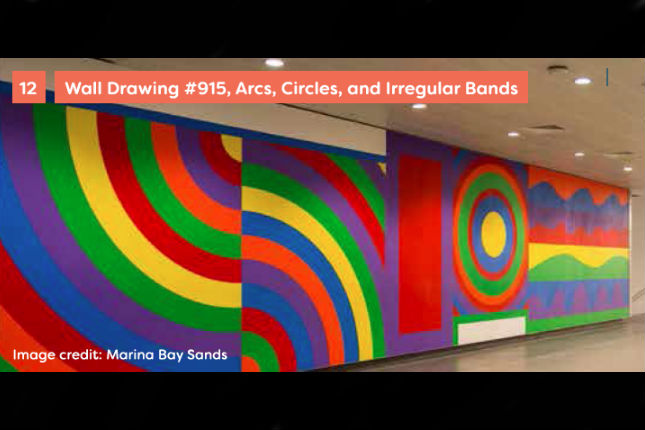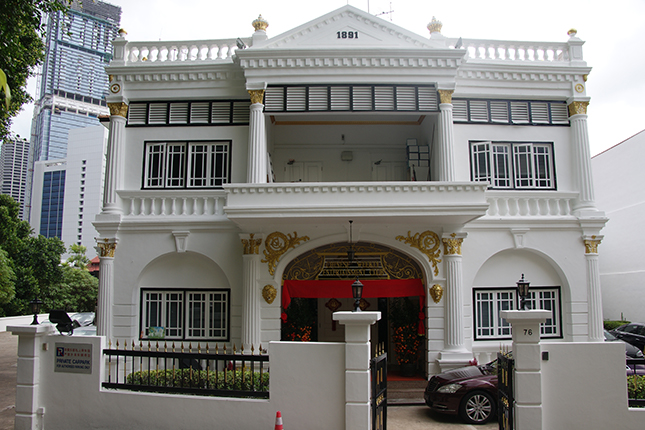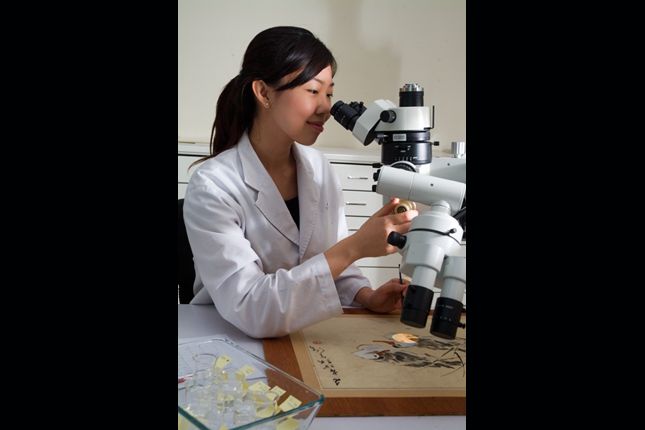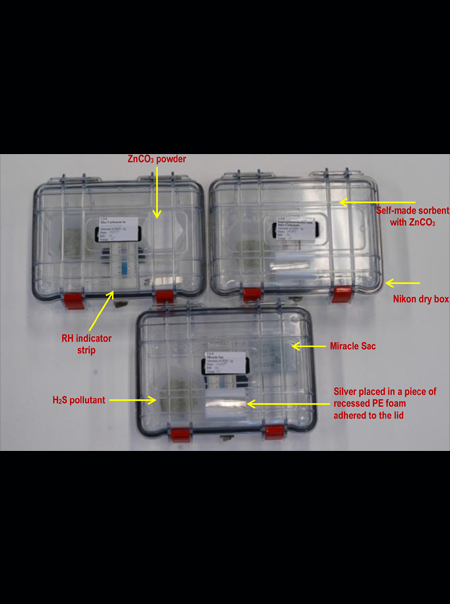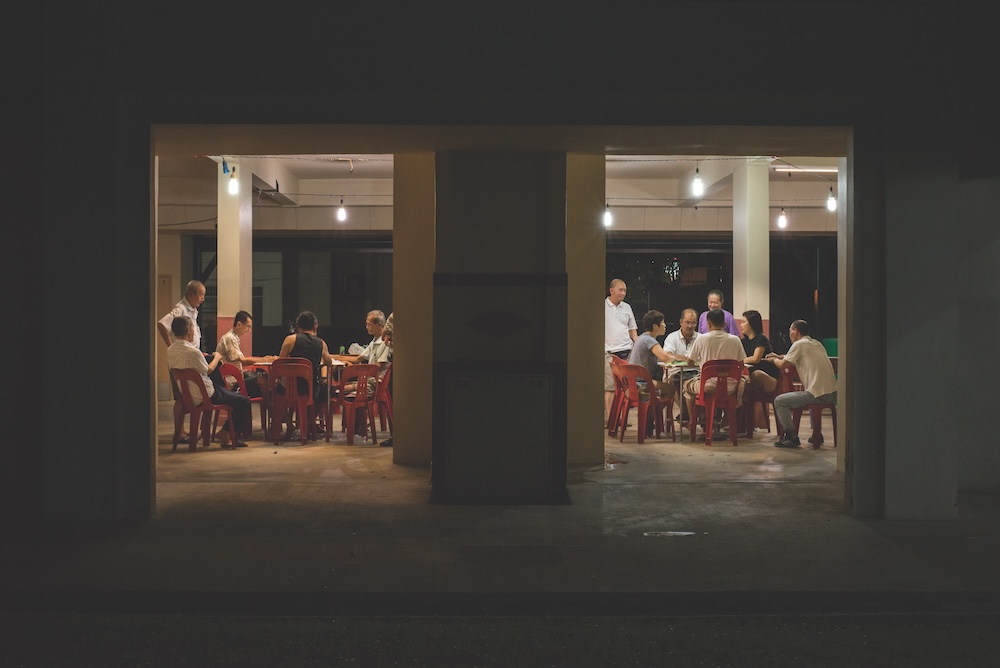Text by Low Sze Wee
BeMuse Volume 4 Issue 2 – Apr to Jun 2011
A recent edition of BeMUSE1 featured a painting by Pu Ru 溥儒 (1896-1963) titled A Copy of the “Beauties on an Outing” by Li Gonglin from the Asian Civilisations Museum collection (Fig.1).

Apart from its intrinsic beauty, the work epitomises a key feature of Chinese painting, which is a reverence for the past through the act of copying. As its title suggests, the painting is based on a work attributed to an earlier artist, Li Gonglin 李公麟 (1049-1106), from the Song dynasty.2 Li's work is also similar in composition and style to another painting, possibly done by the Song emperor Huizong 徽宗 (r. 1100-1126) who had in turn copied a now-lost work of Tang dynasty artist Zhang Xuan 张萱 (713-755)!3
A colophon was later added to Pu’s painting by scholar Rao Zongyi who pointed out that Pu was mistaken in thinking that the subject he chose was of a concubine leaving the court. According to Rao, the depicted scene is actually Lady Guoguo’s Spring Outing. The original painting by Li Gonglin is in the National Palace Museum in Taipei and can be used for verification (Fig. 1a).

The Tradition of Copying
Copying is a common method of art training in many cultures. This is especially so for the ancient tradition of Chinese painting also known as maobi hua 毛笔画 or shuimo hua 水墨画. The tools used for such paintings (ink and colour pigments applied with a brush on paper or silk) have remained largely unchanged over 3,000 years.
In China, copying is a commonly accepted means of learning painting and calligraphy. As early as the sixth century, Xie He 谢赫 had mentioned the copying of old masterpieces as one of the Six Laws or Principles of Chinese painting aesthetics.4 Closer to our time, there is a well-known episode in the 1940s when Zhang Daqian and Xie Zhiliu spent nearly a year to document the Dunhuang cave murals in Gansu province by painting life-size reproductions. Interestingly, the murals themselves were also the result of copying in ancient times. The paintings’ outlines were initially produced through stencils. Relying on these stencilled outlines, Dunhuang artists then painted the final images directly on the walls. Zhang Daqian’s remarkable copying skills have given rise to a number of enduring controversies. One of the most prominent is the case of The Riverbank – a painting attributed to the 10th century master Dong Yuan by its owner, the Metropolitan Museum of Art in New York, but which some recent scholars have suggested is a modern fake by Zhang.5
In Chinese painting, a beginner usually learns by copying his teachers' brushwork and composition, and from studying extant masterpieces, reproductions and instruction manuals. Once he has attained a sound foundation, he is then expected to develop a personal language that is a synthesis or reinterpretation of past styles, and one that reflects his personality, temperament and character. This is not to say that Chinese artists do not observe nature or are inept in capturing physical likeness. For them, studying nature is a key ingredient in art, but copying is a proven method of studying how earlier artists translated the physical form and, more importantly, the spirit of the three-dimensional world onto the two-dimensional surface of a painting. Moreover, in an era when mechanical reproduction was not yet available, making hand-painted copies was the only way of circulating widely admired works amongst artists and collectors. For instance, Su Shih 苏轼 of the Song dynasty was known to have lent old paintings to friends who wanted to have copies made.6 Sometimes, artists even created copies as a joke or to test their friends’ knowledge. And in a society where much respect is accorded to seniority and ancestry, artists have long been regarded as custodians and transmitters of culture and tradition. Hence, creating a work that refers to the past, especially the styles of great masters, signals an artist’s intent to be included as part of an illustrious lineage. In this way, making copies of paintings is seen as an exercise in virtuosity by artists who revere history. Pu’s painting, with its declared connections to antiquity, is a clear example of such aspirations.
Generally, there are three ways to make copies. The first is to make an exact copy by tracing an existing work (known as mo 摹). This ensures that the entire composition and scale are reproduced very closely. However, because tracing has to be done slowly, the final brushwork may lack fluidity and a sense of spontaneity. The other way is to make a freehand copy by studying the original closely (known as lin 临). In this more technically demanding method, the artist has more freedom in his brushwork, but an exact copy is virtually impossible. The third category of ‘copy’ paintings refers to works done in the style of a particular artist but not based on any specific painting. For such works (sometimes known as imaginary copies), an artist creates a new composition in the style of another. In the hands of a skilful artist, it is possible to get a good copy very close to the style of the master with confident free-flowing brushwork. Two paintings in the Asian Civilisations Museum collection, Landscape in the style of Huang Gongwang by Wang Yuanqi 王原祁 and Ink Plum Blossoms done in the style of Wang Mian by Qian Du 钱杜, are good examples of such imaginary copies. (Figs. 2 and 3)


The Problem of Copies
The general acceptance and proliferation of copies in Chinese art have made it conducive for unscrupulous dealers and artists to pass off copies as originals. Some Chinese connoisseurs consider it impolite or inelegant to expose the works of forgers; as a result, certain fraudulent works continue to be circulated in the market.7 For instance, artist and connoisseur Xiao Ping (b. 1942) was once asked by a friend to write a colophon on a painting of chrysanthemums by Fu Baoshi (1904-1965) which he felt was a fake. However, as the collector was a senior official whom he did not wish to offend, Xiao penned a colophon based on a poem of chrysanthemums by Fu, without mentioning the quality of the painting. He had hoped that whoever read his colophon in the future would be able to read between the lines and understand that he had declined to give an opinion on the authenticity of the painting.8
Therefore, given the presence of an active art market, the existence of forgeries in China, as in other countries, is unsurprising. However, the circulation of copies is not only a problem for unwary collectors. It also poses challenges for curators and art historians who have to ascertain the authenticity of works in order to construct an accurate history of an artist’s practice and in the process, establish a better understanding of Chinese art history.
General Principles Of Authentication
Generally, the task of authenticating involves close examination of two main aspects of a painting – dating and authorship. Firstly, one has to determine if the work comes from the period of its purported date. If undated, then the work should have been produced sometime during the artist’s lifetime. This involves technical analysis to assess the age of the materials used in the painting. Advances in scientific analysis have made the results of such tests generally objective and incontrovertible. However, for authenticating recent paintings, especially those by 19th and 20th century artists, such tests are less helpful as forgers usually have little difficulty in obtaining raw materials which are still relatively plentiful today. Moreover, in a heated art market where demand for paintings exceeds supply, it is not inconceivable for copies of a famous artist’s works to be produced and sold even during his lifetime, which makes it even more difficult to authenticate a work based on its age.
That said, the correct age does not necessarily mean that the painting is authentic. After the age of the materials has been verified, the next task is to determine if the artist is the author of the painting. An authenticator’s conclusions are drawn after looking closely at the painting and comparing it with authentic works. This requires the authenticator to have an intimate understanding of the artist’s practice, down to details like the artist's favoured type of paper to the places he travelled to and the people he met during his lifetime. It also requires a sufficiently large number of reliably authentic works for comparison. This can be a problem with very old works as few original works prior to the Song dynasty have survived. Sometimes, an artist may produce two genuine works with the same subject matter but of different quality. This poses difficulties later on as authenticators will have to decide which of the two genuine works to use for comparison purposes. Similarly, forgers may sometimes forge the works of artists whose paintings are long-lost, hoping that such works could never be verified against authentic extant ones.9
Ambiguous Cases
However, the question of what comes from the artist’s own hand is made murkier by paintings copied with the knowledge or authority of the artist. This has happened when the artist could not cope with high demand for his paintings and had to rely on students or relatives who could make relatively faithful copies to supply the needed works.10 The artist would complete the copy by writing the accompanying inscription and signature, with perhaps a few additional brushstrokes here and there to ‘improve’ the painting.11
Equally controversial is the practice of separating a painting into two. Chinese paintings are usually done on paper made from multiple layers of pulp. For a sufficiently thick painting, a skilful mounter can divide the work into two by carefully separating the paper layers to produce two thinner sheets. This results in two identical paintings. Both layers bear the same image since the ink would have penetrated both layers during the painting process. The only slight difference is that the image on the top layer tends to be sharper and have richer tones than the one on the bottom.12 However, it could be argued that both paintings remain authentic as they came from the artist’s hands and no third party was involved in the painting process.
To complicate matters further, there are recorded instances when a famous artist such as Dong Qichang 董其昌 (1555-1636), whose works were very much in demand, sometimes even permitted his friends to use his name on their own works.13 Another similar episode recounts how an impoverished senior artist, too embarrassed to ask Zhang Daqian for a painting, once invited Zhang to paint a joint work, which the latter agreed. Zhang first painted the figures and the senior artist later added the landscape elements. For such a collaborative work, both artists would usually sign the painting. However, in this case, the senior artist did not sign and instead asked Zhang to write the inscription. Sympathetic to the senior artist’s plight, Zhang complied with the request, even though he realised that the work could eventually be passed off as a painting done entirely by Zhang, and hence command a higher price as compared to a collaborative work.14
Specific Methods of Authentication
1. The Materials Of The Painting
As mentioned, the first task is to determine if a work comes from the period that it purports to date from. If undated, then the painting should have been produced sometime during the artist’s lifetime. A visual inspection is not sufficient as there are ways to create an aged or faded effect on new materials. For very old paintings, it is possible to send the paper or silk on which the painting is done, or the silk on which the painting is mounted, for scientific analysis. These tests usually provide a broad time period within which the paper or silk was made. Hence, they are more useful for authenticating older paintings rather than recent works. However, it should be noted that it is always possible for a resourceful forger to obtain old paper, silk and even ink sticks to make ink, and use them to create forgeries. This could extend to pulping blank pages from an old book to produce a piece of ‘old’ paper!15 Hence, even for genuinely old paintings, it is still necessary to determine if the painting was likely to have been painted by the artist.
For more recent works where the age of materials is not a useful guide of authenticity, an authenticator should be familiar with the types of paper, ink, seal paste and scroll mounting that the artist prefers or usually works with. Hence, a painting done on paper of a certain type would be suspect if the artist is not known to use that particular paper. However, such tests are never definitive. One can imagine a few possible scenarios where such anomalies may occur. For instance, the artist might have bought some new paper to try on but gave up after a few attempts. If those preliminary works survived, they would be hard to place within the artist’s overall output, especially if the artist did not mention these attempts to anyone.
2. Scrutinising The Subject Matter
Once it is ascertained that the materials used are of the type that the artist is likely to have used, the next step is to determine if the subject matter of the painting is typical of the artist for that particular period of his career. In this case, the subject matter refers to all the visual elements found on the painting surface: the images (be it a landscape, bird and flower or human figures), the calligraphic inscriptions and signatures, and the seals.
In terms of the imagery, the authenticator should ascertain whether the artist is known to have painted certain subjects during a particular period. For instance, an artist may be known for painting landscapes but not for human figures. Likewise, the authenticator should also examine the calligraphic inscriptions, signatures and seals to see if they are typical of the artist for the period in question. For instance, some artists may change their signature or the type of seals they use as they get older. Hence, a painting is likely to be a forgery if it bears a signature or seal that is chronologically inconsistent with the artist’s known practice. A careful reading of the inscriptions may also be helpful in authentication. For example, a careless forger may write an inscription purporting that the painting was a gift for a famous patron, but mistakenly include a date beyond the lifetime of the said patron.
3. Question Of Style
Even if the subject matter is typical, the authenticator then needs to determine if the manner or style of painting and writing is typical of the artist and corresponds to his known style for that particular period. This would involve comparing the work in question with known authentic paintings of the same period. In analysing painting and writing styles, emphasis is paid on the brushwork, use of ink and colour, and overall composition. Brushwork can be expressed in many ways – dry or wet, dense or sparse, thick or thin, light or heavy, broken or continuous, smooth or energetic, soft or angular – the permutations are endless. Likewise, the use of ink and colour can be similarly varied from light to dark, sparse to heavy. Composition may also be highly individualistic, balanced or asymmetrical, static or dynamic and so on. In terms of writing, it is important to compare the spacing between columns and characters to ascertain if there is a pleasing rhythm in the flow of characters and a balanced, harmonious composition. Such stylistic analysis is based on the assumption that most artists, though their styles may change with time, usually paint and write in a certain way for a particular period.
4. Determining Quality
Once it has been determined that the subject matter and style are consistent with the artist’s, the next aspect – quality – is the most difficult to ascertain. There is a common assumption that great artists always create good work, and a work of an ordinary or mediocre standard can never come from his hands. From a great artist, most would demand forceful brushwork, confident calligraphy, lively imagery, and a harmonious, if not striking composition. These are qualities that can reasonably be expected from works produced at the peak of his career. However, this necessarily also implies that works completed at an earlier age (when the artist’s skills were not yet fully honed or he was in transition between styles) or in his later years (when his physical faculties or energies were faltering) will understandably exhibit fewer of these desirable attributes. Forgers sometimes forge works from these periods precisely because authentic works created during those periods do not bear the artist’s mature style and will usually be accepted by collectors as being of secondary quality.16
In addition, a Chinese painting may be completed within a few hours, if not minutes. Hence, an artist could conceivably produce thousands of works in his lifetime. Therefore, it is unrealistic to expect every single work to exhibit the same high standards. Inevitably, there will be works of a lower quality, perhaps produced when the artist was unwell, tired, uninspired or simply, socially obligated.
5. Tracking The Provenance
Lastly, after ascertaining that the age, subject, style and quality are consistent with the artist’s works of that period, the authenticator can further verify the work’s authenticity through its provenance, that is, the history of ownership of the work. This could be evident from the colophons – additional inscriptions – written by the painting’s various owners, either on the painting itself or its silk mounting borders. This is an accepted practice where owners either impress their seals or write a short piece of text to signal their ownership and appreciation of the work. This could then be verified against painting inventories maintained by the same collectors, where available. Emperors like Huizong from the Song dynasty and Qianlong (r. 1735-1796) from the Qing dynasty were famous for their inventories and these have proven invaluable in authenticating many paintings. However, listings in such inventories alone are not very useful as these inventories were seldom illustrated. Moreover, many artists tended to paint similar subjects or give their paintings similar titles such as ‘Fishing in the River’ or ‘Dwelling in the Mountains’, thereby making verification through such listings problematic. In recent times, it has become possible to obtain some form of verification from recollections of direct witnesses. These could be students, family members, collectors or close friends of the artist who were present when the painting was completed. These same individuals, if reliable, could also provide valuable information to prove that the painting was unlikely to have been produced by the artist. This is especially if they are privy to information that is not publicly known such as the artist’s likes or dislikes, or his habits when painting.
Difficulties of Authentication
It is important to always keep in mind that authentication remains a subjective test. Apart from an artist’s direct testimony, all other evidence will be circumstantial, and the conclusion can never be definitive. In some instances, it is even possible to question an artist’s testimony, especially if his memory is failing or there are special circumstances where he may want to hide the truth. For instance, a Singapore art collector recounted that when the famous painter Guan Shanyue 關山月 (1912-2000) visited Singapore in 1986, he was asked by many local collectors to authenticate works in their collections. When confronted with fakes, Guan would make light of the awkward situation by joking that “I have painted numerous paintings over the decades, but I don’t seem to remember having done this particular one. In any case, this artist can probably do a better job than I can!”17
After a thorough examination, the authenticator can, at most, opine that the painting is likely, very likely or unlikely to be the work of the artist. Even if the painting comes with a certificate of authenticity signed by the artist, there is no assurance that the work in question has not been replaced with a copy whilst in circulation. Generally, there are only a few instances when one can be reasonably certain that a work is genuine. They include works uncovered from archaeological sites, works obtained directly from the artist in his lifetime, and works donated by the artist to a public museum. In the latter case, it is then clear that the paintings did not have a chance to circulate in the open market where copies could be switched for originals.
Authentication requires very careful analysis and the application of any type of test will have to be done on a case-by-case basis. There are plenty of exceptions to the rule that have to be taken note of. For instance, when analysing a work based on an artist’s subject type, it is helpful to know that an artist’s subject preferences can change over time or he may favour several subjects concurrently. In addition, a landscape painter, pressured by a close friend or an important patron, may feel obliged to produce a portrait if faced with such a specific request. In such circumstances, it is understandable if the artist does not publicise the work’s existence. Hence, the fact that such works are unknown does not conclusively prove that they are not authentic.
Likewise, it is inaccurate to assume that an artist only has one style of painting at any given period. A skilled artist could conceivably be proficient in several styles at the same time. For one occasion, he could paint a landscape in a spare style, done in pure ink with quick brushwork. For another occasion (or perhaps for a different patron), he could choose to depict the same landscape in a more decorative and elaborate style, full of colour and intricate detail. Sometimes, even stylistic analyses may not be very helpful. For instance, experts see little use in analysing Ming artist Qiu Ying’s signature when authenticating his works as Qiu had felt that his calligraphy was inferior and often invited friends to sign his works for him.18
When analysing a painting’s quality, it is important to keep in mind the possibility of authentic works of low quality. Although many artists would be loathe to sell or give away inferior works, sometimes low-quality but authentic works may still leak into the open market without their knowledge. For instance, it is known that Xu Beihong had a habit of practising painting and calligraphy every morning, and often discarded unsatisfactory works by throwing them aside. Unknown to Xu, some admirers retrieved some of these unsigned works as keepsakes which later surfaced in the open market with spurious signatures or seals added on.19 Strictly speaking, these works cannot be considered fakes. Therefore, it is useful to keep in mind that a mediocre work does not necessarily mean that it is not authentic.
Lastly, just as the skills of authenticators increase over time, so have the abilities of resourceful forgers. For example, forgers are aware of the value placed on colophons for authentication. Hence, they are known to remove true colophons from original paintings and pair them with forged paintings in an attempt to give the fakes a veneer of pedigree. Similarly, a forger could also pair a fake colophon purportedly by a famous name with an authentic painting by a lesser name, in order to elevate the value of the painting.20 Art historian James Cahill has highlighted that Zhang Daqian sometimes asked other artists, collectors and connoisseurs to write laudatory colophons for his copies so that they could be passed off as originals.21
The Value of Copies
However, at the end of the day, it should be noted that authentication is not just merely a case of comparison, trying to match and identify elements in order to expose a fake. The ability to authenticate a specific painting by an artist and place it in connection with the rest of his works contributes immeasurably to our understanding of the development of his practice. This, in turn, provides a more stable foundation on which to build a better understanding of Chinese art history. Lastly, it is important to keep in mind the advice of art historian Wang Yao-t’ing, who once highlighted that when confronted with a Ming copy of a Song painting, one could adopt two possible perspectives: it is a fake from the Song perspective but nevertheless, a genuine work from the Ming period.22 Hence, once the painting is returned to its proper context, there is still value in the work and much to be learnt from it.
Low Sze Wee is Deputy Director (Heritage), Ministry of Information, Communication and the Arts.
Notes





